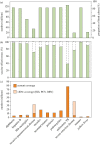Biological challenges to effective vaccines in the developing world
- PMID: 25964451
- PMCID: PMC4527384
- DOI: 10.1098/rstb.2014.0138
Biological challenges to effective vaccines in the developing world
Abstract
The reason for holding a meeting to discuss biological challenges to vaccines is simple: not all vaccines work equally well in all settings. This special issue reviews the performance of vaccines in challenging environments, summarizes current thinking on the reasons why vaccines underperform and considers what approaches are necessary to understand the heterogeneity in responses and to improve vaccine immunogenicity and efficacy.
Keywords: immunization; immunology; infectious disease; vaccine; vaccinology.
© 2015 The Author(s) Published by the Royal Society. All rights reserved.
Figures


References
-
- World Health Organisation, UNICEF & World Bank. 2009. State of the world's vaccines and immunization, 3rd edn Geneva, Switzerland: World Health Organisation.
-
- WHO/UNICEF. 2014. Estimates of National Immunization Coverage for 2013. Geneva, Switzerland: WHO.
-
- United Nations. 2013. World Population Prospects: The 2012 revision. New York, NY: Department of Economic and Social Affairs, Population Division.
-
- Vitek CR, Wharton M. 2008. Diphtheria toxoid. In Vaccines, 5th edn (eds Plotkin SA, Orenstein WA.), pp. 139–156. Philadelphia, PA: Saunders.
Publication types
MeSH terms
Substances
Grants and funding
LinkOut - more resources
Full Text Sources
Other Literature Sources
Medical

